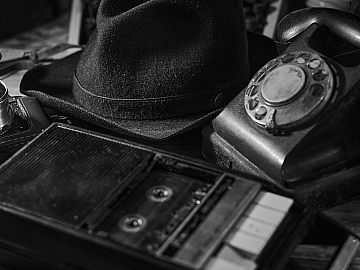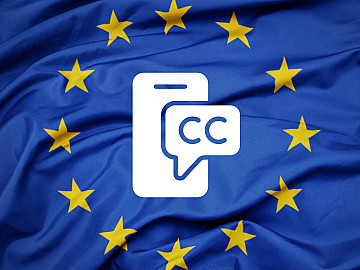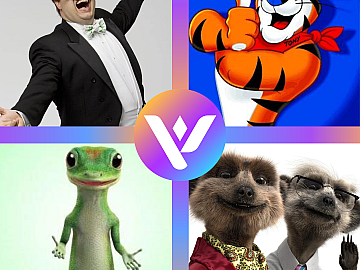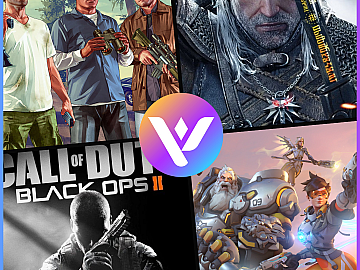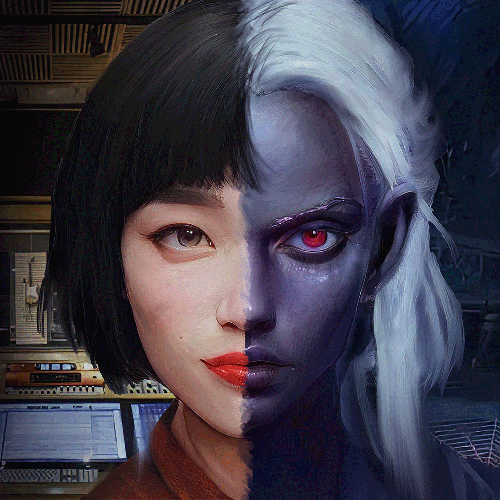Let’s continue our journey exploring our industry’s intriguing and surprising roots.
The last piece covered the early history of the industry in Part 1 of this series. If you missed it, be sure to start there first.
We’re thrilled to be back with part 2, and we’ll be taking you on a guided tour from where we stopped in part 1, to start from the magnetic 1970s until the digital present.
We will cover the landmarks in the extensive history of voice-over and demonstrate how voice-over has shaped other connected sectors.
Without further ado, let’s jump in.
The Magnetic Era
The 1970s – The Birth of Audiobooks
The early 1970s saw the Sony Walkman’s western popularity soar: the cassette player stormed the world. The trademark Walkman name quickly garnered use as the unofficial term for ALL personal audio devices.
The growth of magnetic tape technology, post-WWII, resulted in magnetically recorded audio becoming the standard.
Cassette tapes were one of the storage devices that came from this magnetic era. These devices overtook the record player in its market share, in no small part due to the remote nature of the playback devices. One of which was the Sony Walkman.
Listening to music was the primary use for the Walkman and similar devices; however, another form of entertainment emerged—the audiobook. 
Audiocassettes presented an ideal medium for abridged audiobooks to come to the fore. Audiobooks were narrated, recorded, and distributed in audiocassette forms for playback devices like the Walkman and in-car stereo cassette players. Publishers also released unabridged audiobooks, but fewer numbers due to the number of cassette tapes required to store a full reading.
This incredible development also opened up literature to brand new audiences. Disabled and foreign audiences alike could easily engage with written media due to increasing accessibility options.
Olympic Gold Medalist Duvall Hecht pioneered this revolution by founding Books On Tape in 1975, specialising in—you guessed it— putting books on tape!
Engrossing and engaging voices were necessary for the audiobook industry’s success – and by the end of 1987, the niche market was worth a tidy $200 million. Today, it is worth $1.5 billion.
1979 – Darth Vader
The end of the 70s and the beginning of the 1980s was a hectic time in voice-over history. Using a voice-over in films wasn’t unusual by any means. ADR (Automatic Dialogue Replacement) was already a popular method of re-recording an actors lines in a professional studio environment. However, besides animation and foreign film, few movies required complete dubbing in the same way as Darth Vader’s character in Star Wars.
Released in 1977 to roaring success, Star Wars: A New Hope and its sequels The Empire Strikes Back and Return of the Jedi in 1980 and 1983, respectively, made Darth Vader a legend. He was wowing cinema-goers with his unusual and distorted voice. Significantly, his lines are all dubbed by James Earl Jones, the on-set performance by David Prowse.
Jones’ darker, heavier, and intimidating voice fit Darth Vader like it was fated. Definitely one of the best decisions in cinema history. Can you imagine Darth Vader with any other voice?
The Digital Era
The 1980s – Early voice-over in video games
Video games media demonstrates best the early developments in the digital era. Castle Wolfenstein, released in 1981 for the Apple II, is one of the first proper instances of voice-over in video games. The player character, B.J. Blazkowicz, with the arduous task of escaping Castle Wolfenstein – A heavily fortified Nazi compound.
The inclusion of speech amped up the intensity of the gameplay. The Nazi guards shouting “Halt!” and “Kommen Sie!” (You come!) in a fruitless attempt to prevent escape. The low quality of the audio recordings, a consequence of the time’s limited technology, added a raspy shriek to the audio clips, which added to the player’s anxiety.
The inventive game developer, Silas Warner, was singularly responsible for the implementation of audio and speech. He invented a new digital audio recorder, aptly named “Voice”, and this unique device set the bar for early video game voice-over.
In the succeeding decades, professional voice acting has become a borderline necessity to keep distracted gamers engaged with the story.
Borrowing much from cinema, the bar for quality is a galaxy away from where we began. Today, video games include some of the best voice acting performances in the history of voice-over.
The 1990s – The Digital Revolution and the Role of Unions
The impact of digitisation of information and the internet has not been understated and marked the biggest revolution in voice-over history.
It is effectively democratised, freed from the bounds of traditional (and expensive) studio recording processes making audio production more accessible.
The internet gave control of content production to anyone with the know-how to put the content together digitally. Digital Audio Workstations (DAWs) ‘ thriving development made it easier than ever for a small studio or independent artist to put out quality content. Ecommerce was still in its infancy, but many still found success with the combination of more affordable equipment and online distribution.

Essentially, it was easier for anyone to; connect with talent, edit audio, distribute content, and record voice-over. In these early days of connectivity, most live directed voice-over sessions happened via ISDN (Integrated Services Digital Network) technology, transmitting the audio studio to studio via traditional telephone networks. In the 90s, ISDN was still expensive, but TV and radio networks frequently used the technology to record voice-over for radio and TV commercials with known talent.
The acting unions strictly controlled the early days. A voice actor would show up, record their lines, and receive their agent or union’s payment. A voice actor’s role would be solely for their vocal talents. But this is not how it works now, with most voice actors recording in home studios, negotiating personal rates, and often editing the final content.
The technology barrier continued to crumble as prices fell and recording quality soared, making it truly accessible for the layman to create pro audio. Sound cards, the advent of the uncompressed .wav file, and the proliferation of affordable PCs created a market where an experienced voice actor could cash in independently.
The 1990s – Anime and Otaku
Animation in the west continued to flourish under the direction of Disney and Pixar. In the East, the industry was on the verge of blossoming into a powerhouse. Japanese animation, better known as “Anime”, relied heavily on talented voice actors to breathe life into the characters.
Anime also had a significant presence in Japanese culture in the 1980s, with massively successful hits like Hayao Miyazaki’s Nausicaä of the Valley of the Wind (1984) and Dragon Ball (1986). However, the industry began to decline with the economic bubble bursting and following a decline of the Japanese economy.
Fortunately, in 1995 the industry was reinvigorated by the ground-breaking anime Neon Genesis Evangelion, written by auteur director/writer Hideaki Anno. Evangelion teenage characters’ damaged psyches, brought about by Anno’s depression, required exceptional Japanese voice actors.

The “post-Evangelion” industry was dominated by character-driven stories and mecha anime (meaning giant robot). Neon Genesis Evangelion eventually being localised into numerous languages through voice-over dubbing.
Setting the quality bar high, 26 episodes with top-notch animation, writing, direction, and voice acting became the standard, which is a trend that continued into Cowboy Bebop (1998), RahXephon (2001), and more. Anime has become less niche over time. Miyazaki’s Studio Ghibli celebrated title Spirited Away (2002) was the first non-American film to win the Academy Award for Best Animated Feature.
The result of this success was Otaku culture. A dedicated fanbase of Anime enthusiasts that live and breathe anime. There are few arguments in the voice-over world as intense as the “Sub vs Dub” discussions (Japanese voice with subtitles vs English dubbing work) in Otaku communities.
The popularity of this industry has continued to grow uninterrupted. It is hard to find a voice actor who doesn’t already have anime localisation and dubbing work in their portfolio.
Voice-over in the 21st Century
Celebrities in Voice-over
In recent decades, voice-over has legitimised itself, now viewed as a promising career. While there are still those who do not consider voice acting to be “real acting”, this is an outlook eroded year on year.
One of the chief reasons for this change is that many of the cited “real actors”, the celebrities lend their voices to commercials, video games, and audiobooks. Of course, this has been the case in animated films for decades, with figures like Tom Hanks as Woody in Toy Story.
In video games media, the trend started to take off in the noughties, with celebrities like Patrick Stewart and Samuel L Jackson voicing characters in The Elder Scrolls and Grand Theft Auto franchises, respectively.
Throughout the 2010s, celebrity voices became a commonplace addition to any AAA video game title. Some celebrities have found outstanding success in the video games medium, such as Christopher Judge’s performance as Kratos in God of War (2018).
Motion Capture (MoCap) technology allows animators to capture the actors’ visual likeness and facial expressions, e.g. Kit Harrington in Call of Duty and Keanu Reeves in Cyberpunk 2077.
It is rare to see a new release in the animation industry that doesn’t feature a celebrity in its cast. It is a large portion of the marketing cycle for any new release.
These acts further serve to validate the professional value that has built up across the history of voice-over.
Emerging voice-over trailblazers
While there is an assortment of celebrities making their way into voice acting, there are also well-known names that have grown within this industry. Specific figures show up as voices in what feels like every piece of animation and video game media.
Voice actors like Nolan North, Troy Baker, Jennifer Hale, Laura Bailey, Steve Blum, etc. These people have crafted their professional space due to an unrelenting dedication to their art. As a result, these people have celebrity status in gaming circles.
Video games, anime, western animation – each of these industries rivals typical Hollywood films for the attention of entertainment lovers. So, it only makes sense that voice actors start to become the beneficiaries of this growth.
The New Digital Frontier
The growth of YouTube has opened the floodgates to a prosumer culture. The blurring of lines between producers and consumers of content has further diversified the creation process. Opportunity is abundant for countless industries in this environment, none more so than voice-over.
Online video platforms have become a prevalent format for entertainment. The wealth of concepts and fresh ideas on websites like YouTube are countless. Explainer videos, independent animation, narration for YouTube vlogs and stories, corporate video content, and more. Many of these video formats requiring professional voice-over services to amplify their messaging.
There is an unlimited number of channels on YouTube looking to produce professional-quality content with the best YouTube voice-over they can find.
Excess Supply and Ease of Access
The growth of broadband technology, faster computing speeds, and the proliferation of freelancing networks have led to online remote productions being the norm. Becoming a freelance voice-over talent in 2021 is as simple as having a quality condenser microphone, computer, and access to a website like Fiverr or Upwork.
These P2P voice-over websites do not assure quality; however, the pure quantity of low-cost talent has made competition fierce and created an overflow of supply. As a newcomer, getting noticed can take a lot of time. This is where platforms like Voquent exist, only accepting professional voice-over talent vetted and approved before being made available for casting.

However, this ease of access has undoubtedly demonstrated the individuality of voice-over artists. Never in the history of voice-over has the artist had such control over the work they agree to take on and the quick career growth they can achieve.
Adapting affordable DAWs (Digital Audio Workstations) to a primarily software model has garnered more benefits to the voice-over artist. Anyone can download Adobe Audition or Audacity and get to work editing audio.
Voice-over has been decentralised – moving control from studios and clients into the hands of the artists themselves. A far cry from the early days of animation where actors wouldn’t even get credited!
The digital era has given birth to a world where voice-over talent can set up a recording studio and work anywhere, circumventing the need to be based in a specific city or region.
While voice actor unions can offer some welcome assurances, a voice actor doesn’t need an agent or representative to ply their trade.
While the industry is doubtlessly populated, it is easier than ever to get started, and more opportunities are appearing for voice-over professionals all the time.
Closing Thoughts
The history and business of voice-over have transformed over time, from an afterthought to being the forefront of countless mediums.
The long and rich history of voice-over is inherited by the talent using their voices every day to inform, sell, teach and entertain.
Voice Actors with home studios have more autonomy than at any time, with daily opportunities to reach mass audiences. And more exciting times are ahead! We hope you’ve enjoyed this short overview of the history of our beloved industry, but I’m sure we’ve missed something of vital importance. Be sure to join the conversation on Twitter and let us know!
While this article has provided you with the history of voice-over as an industry – it’s not over yet. History is not just then; it is now too. This industry will continue to develop and is developing currently. Who knows what could be next?
We will explore this next time – where we take a look at the future of the industry.
Sometimes we include links to online retail stores such as Amazon. As an Amazon Associate, if you click on a link and make a
purchase, we may receive a small commission at no additional cost to you.




